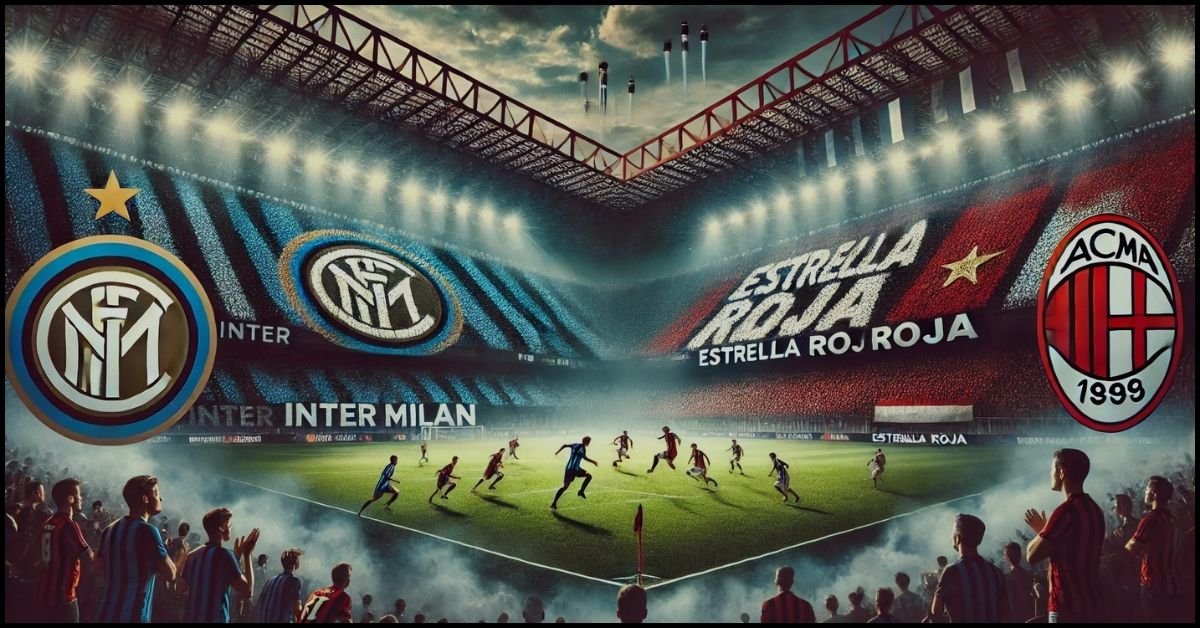When Inter vs. Estrella Roja (Red Star Belgrade), it’s not just a football match—it’s a collision of rich footballing histories, passionate fanbases, and contrasting cultures that have shaped the beautiful game. The rivalry between these two iconic European clubs is a story of footballing evolution, remarkable achievements, and fierce competition.
This clash represents more than just a game on the pitch; it encapsulates decades of footballing tradition, unforgettable moments, and an ongoing quest for supremacy in European club football. This article will delve into the fascinating history, tactical differences, and cultural significance of Inter Milan vs Estrella Roja—two clubs with storied pasts, distinct playing styles, and a fierce will to succeed.
Historical Background: Inter Milan vs. Estrella Roja
Inter Milan: A Powerhouse in Italian Football
Inter Milan, known as Internazionale, was founded in 1908 and has become one of Italy’s most prestigious clubs. With a history filled with domestic and international triumphs, Inter has solidified itself as a powerhouse in European football. The club has won 19 Serie A titles, 3 UEFA Champions League trophies, and numerous Coppa Italia titles, establishing a legacy that spans generations.
Inter’s golden era arguably came in the 1960s under the legendary coach Helenio Herrera in international football. His implementation of the catenaccio system—defensive football with swift counter-attacks—made Inter a dominant force in Italy and Europe. Inter’s European success, including their back-to-back European Cup victories in 1964 and 1965, solidified the club’s place in the annals of footballing history.
Estrella Roja: Glory in Eastern Europe
Estrella Roja (Red Star Belgrade), founded in 1945, is one of Eastern European football’s most successful and beloved clubs. The Serbian giant has a rich history in domestic competitions, with numerous Yugoslav First League titles and Cup victories. However, their most significant achievement came in 1991 when Red Star won the European Cup, the precursor to the UEFA Champions League.
Led by manager Ljubiša Tumbaković, Red Star achieved glory in European football, defeating Olympique Marseille in the final. That victory remains the pinnacle of the club’s achievements. Estrella Roja’s iconic red-and-white striped shirt continues to evoke nostalgia for fans who remember that golden age of Yugoslav football.
Red Star’s distinctive attacking style, often centred around fluid, free-flowing football, made them a formidable European force during their heyday. Their triumph in 1991 is a testament to their skill, heart, and fighting spirit—values that have endured throughout the club’s storied existence.
Tactical Styles: A Clash of Footballing Philosophies
Inter Milan: Tactical Rigidity Meets Flair
Inter Milan is traditionally known for its tactical discipline and flexible playing style, which adapts to the strengths of its squad. Over the years, Inter has embraced a range of tactical systems, from the catenaccio to more modern formations, such as the 4-3-3 and 3-5-2, as seen under recent coaches like Antonio Conte and Simone Inzaghi.
One of the standout features of Inter’s tactical approach is its defensive solidity. The club often emphasizes maintaining a compact defensive unit, making it difficult for opponents to break them down. This defensive stability is complemented by counter-attacking play, with Inter’s forwards and wing-backs exploiting space left behind by an opponent’s attacking efforts.
Additionally, Inter has always boasted an attacking talent capable of unlocking tight defences. Players like Romelu Lukaku, Lautaro Martínez, and Nicolo Barella have become integral to Inter’s offensive strategy, combining technical skill, physicality, and clinical finishing. While Inter’s play is often based on solid organization, it can be dynamic and fluid in attack when the situation demands it.
Estrella Roja: Free-Flowing, Attacking Football
In contrast to Inter’s tactical rigidity, Estrella Roja is known for its more fluid, offensive approach. Historically, Red Star’s playing style has maintained possession, created passing triangles, and used quick transitions to break down opposition defences. They pride themselves on a free-flowing attacking system, often playing with creativity, flair, and a relentless desire to push forward.
Red Star’s style of play has evolved, but its core principles remain the same. Central midfielders, who can dictate the tempo and initiate attacking moves, are crucial to their system. In the 1991 European Cup-winning side, players like Dejan Savićević and Darko Pančev were pivotal, providing the necessary vision and execution to complement the team’s attacking thrusts.
In modern-day Red Star, the team still emphasizes fast transitions, wing play, and technical precision. The Serbian club has found a unique balance between preserving its attacking legacy and adapting to the demands of modern European football.
Inter vs. Estrella Roja: Iconic Moments and Rivalries
European Encounters: Memorable Showdowns
Over the years, Inter Milan and Estrella Roja have crossed paths on the European stage. While they are not traditional rivals in the sense of other historic club rivalries, each encounter between these teams is charged with anticipation, given the shared history of success on the continent.
One of the most memorable moments came in the 1989-90 UEFA Cup (now the Europa League) when Inter Milan and Estrella Roja faced each other in the round of 16. Red Star triumphed in that encounter, securing a 2-0 aggregate victory. This result was one of the defining moments of the Yugoslavian side’s European journey, further cementing their reputation as formidable opponents in European competition.
Though these two clubs have rarely met in recent years, any future encounters between Inter and Estrella Roja promise to deliver high-quality football. Their contrasting styles—Inter’s methodical approach and Red Star’s attacking flair—make for an intriguing footballing spectacle.
Cultural Significance: More Than Just a Match
The rivalry between Inter Milan and Estrella Roja represents a clash of cultures as much as it does of playing styles. Inter Milan symbolizes the Italian football tradition of tactical discipline, professionalism, and a focus on domestic dominance. The club’s success in Serie A and its European pedigree reflects Italy’s proud footballing heritage.
On the other hand, Estrella Roja carries the spirit of Eastern European football, where passion, loyalty, and community are central to the club’s identity. The Red Star Ultras, known for their vocal and vibrant support, are one of the most dedicated fanbases in Europe. The club’s historical success—notably its 1991 European Cup win—has ensured its place as a symbol of Yugoslav pride.
The cultural clash between these two clubs highlights how football serves as a lens through which national and regional identities are expressed. While the passion for the game is universal, how fans and clubs engage with football reflects their respective cultures’ unique histories, values, and experiences.
Inter vs. Estrella Roja: Key Players to Watch
As the two clubs prepare for their next encounter, fans will closely watch several key players who could decide the match’s outcome.
- Lautaro Martínez (Inter Milan): The Argentine forward is one of European football’s most consistent goal-scoring threats. His movement, link-up play, and ability to finish from any position make him a key player for Inter.
- Romelu Lukaku (Inter Milan): The Belgian striker brings physicality and aerial prowess to Inter’s forward line. His ability to hold up the ball and create space for teammates is crucial in breaking down resilient defences.
- Milan Jovanović (Estrella Roja): Jovanović has been central to Red Star’s attack, with his pace, dribbling, and eye for goal making him a constant threat in the final third.
- Aleksandar Katai (Estrella Roja): The Serbian winger brings creativity and technical skill to the team. His ability to deliver quality crosses and create chances will be vital in unlocking Inter’s defence.
Frequently Asked Questions (FAQs)
When did Inter Milan last win the UEFA Champions League?
Inter Milan’s last UEFA Champions League triumph came in the 2009-10 season, under manager José Mourinho, when they defeated Bayern Munich 2-0 in the final.
How many times has Estrella Roja won the European Cup?
Estrella Roja won the European Cup in 1991, defeating Olympique Marseille in the final after a memorable penalty shoot-out.
What is Inter Milan’s most successful era?
Inter Milan’s most successful era came in the early 1960s, particularly under manager Helenio Herrera, when they won back-to-back European Cups in 1964 and 1965.
What are some notable players in Red Star Belgrade’s history?
Red Star Belgrade has been home to some footballing legends, including Dejan Savićević, Darko Pančev, and Robert Prosinečki—all key players during the club’s European Cup victory in 1991.
What is the Inter vs. Estrella Roja rivalry known for?
While not a traditional rivalry, the meetings between Inter Milan and Estrella Roja are renowned for showcasing contrasting footballing cultures—Inter’s tactical discipline versus Red Star’s attacking flair.
Conclusion: The Significance of Inter vs. Estrella Roja
The clash between Inter vs. Estrella Roja is a testament to the power of football as a unifying force that transcends borders and cultures. With each encounter, we are reminded of the rich histories and traditions that these clubs represent. Inter’s Italian footballing pedigree meets Red Star’s Eastern European flair in a historic rivalry.
Whether you’re a fan of Inter’s tactical discipline or a supporter of Red Star’s free-flowing attack, this match-up offers a fascinating look into two of Europe’s most iconic footballing cultures. As these clubs continue to write new chapters in their storied histories, the future of the Inter vs Estrella Roja clash remains as exciting as ever.

Aiden Cole is a dedicated writer at SpinUpBusiness.com, specializing in delivering insightful content on business, technology, lifestyle, and beyond. With a knack for breaking down complex topics into practical advice, Aiden aims to empower readers with the knowledge they can use in their everyday lives.



